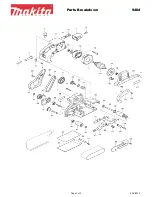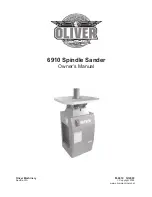
4
English
WARNING
Exercise caution when using this tool. Careless actions,
for even a fraction of a second, can result in serious
personal injury.
INTENDED USE
You may use the sander for the purposes listed below:
sanding on wood surfaces
removing rust from and sanding steel surfaces
polishing and scrubbing porcelain and metal
CAUTION
Keep the cord away from the sanding pad and position
the cord so that it will not be caught on lumber, tools, or
other objects during sanding.
WARNING
Always wear safety goggles or safety glasses with side
shields when operating this tool. Failure to do so could
result in dust, shavings, or loose particles being thrown
into your eyes, resulting in possible serious injury.
OPERATION
INSTALLING ADHESIVE SANDPAPER
Inspect sandpaper before installing. Do not use if broken
or defective.
INSTALLING ADHESIVE (HOOK AND LOOP)
SANDPAPER
See Figure 5.
1. Unplug the sander.
2. Align holes in hook and loop type sanding disc with
holes in pad, then carefully press fuzzy side of sanding
disc against pad as tightly as possible.
NOTE:
Hook and loop type sanding discs can be reused
for the life of the sanding abrasive. It is recommended that
you keep the sanding disc backing pad clean to provide for
best adhesion. Clean occasionally by brushing lightly with
a small brush.
WARNING
Failure to unplug the tool could result in accidental
starting causing possible serious injury.
INSTALLING NON-ADHESIVE SANDPAPER
See Figure 6.
1. Unplug the sander.
2. Release the paper clamp. Remove used sandpaper,
if any.
3. Insert the new sandpaper under the paper clamp.
4. Clamp the sandpaper in place.
TURNING THE SANDER ON/OFF
See Figure 1.
Turn on the sander:
Slide the switch to '' I ''.
Turn off the sander:
Slide the switch to '' O ''.
OPERATING THE SANDER
See Figure 3.
1. Secure the workpiece to prevent it from moving under
the sander.
WARNING
Unsecured workpieces could be thrown towards the
operator, causing injury.
WARNING
Keep your head away from the sander and the sanding
area. Your hair could be drawn into the sander causing
serious injury.
2. Place the sander on the workpiece so that all of the
sanding disc surface is in contact with the workpiece.
CAUTION
Avoid damaging the motor from overheating, be careful
not to let your hand cover the air vents.
3. Turn on the sander and move it slowly over the
workpiece.
NOTE:
Hold the sander in front and away from you,
keeping it clear of the workpiece. Start sander and let the
motor build to its maximum speed, then gradually lower
the sander onto the workpiece. Move the sander slowly
across the workpiece using small circular motions.
Do not force.
The weight of the unit supplies adequate
pressure, so let the sanding disc and sander do the work.
Applying additional pressure only slows the motor, rapidly
wears sanding disc and greatly reduces sander speed.
Excessive pressure will overload the motor causing
possible damage from motor overheating and can result in
inferior work. Any fi nish or resin on wood may soften from
the frictional heat.
Do not allow sanding on one spot too long as the sander’s





























